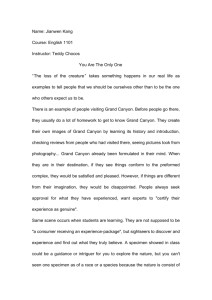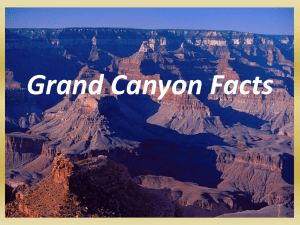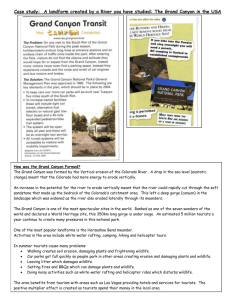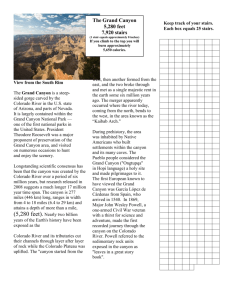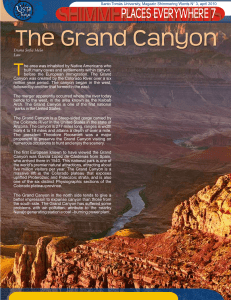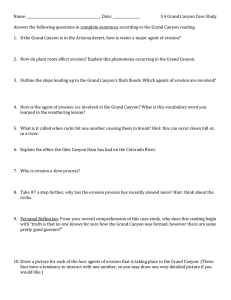Grand Canyon 2 Into the Grand Canyon
advertisement
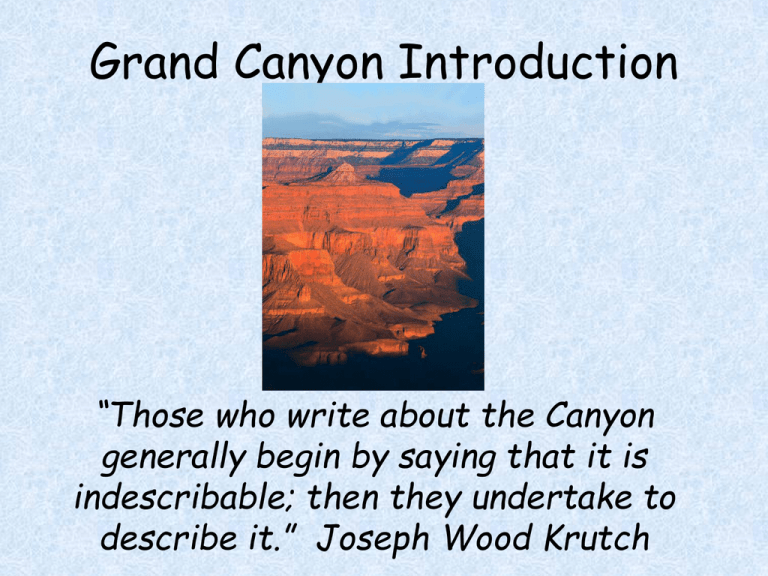
Grand Canyon Introduction “Those who write about the Canyon generally begin by saying that it is indescribable; then they undertake to describe it.” Joseph Wood Krutch Grand Canyon Introduction • 1-1150 BCE: pre-Pueblo people lived in pit houses in area surrounding GC. Grand Canyon Introduction • 1-1150 BCE: pre-Pueblo people lived in pit houses in area surrounding GC. • 800 CE: pre-Pueblo entered building phase, called the Pueblo period. Grand Canyon Introduction • 1-1150 BCE: pre-Pueblo people lived in pit houses in area surrounding GC. • 800 CE: pre-Pueblo entered building phase, called the Pueblo period. • Hopi people modern descendants of prePueblo people. Believe GC is legendary Sipapu, or place of emergence. This is the fourth world and they came through the Sipapu after being forced to abandon the third world, the one directly below. Grand Canyon Introduction • 1540: First European to set eyes on GC: Capt García López de Cárdenas. Sent by Francisco Vásquez de Coronado to find the fabled Seven Cities of Gold, Cíbola. Grand Canyon Introduction • 1540: First European to set eyes on GC: Capt García López de Cárdenas. Sent by Francisco Vásquez de Coronado to find the fabled Seven Cities of Gold, Cíbola. • 1776: Father Escalante first European to visit North Rim. Grand Canyon Introduction • 1540: First European to set eyes on GC: Capt García López de Cárdenas. Sent by Francisco Vásquez de Coronado to find the fabled Seven Cities of Gold, Cíbola. • 1776: Father Escalante first European to visit North Rim. • 1858: Lt Joseph Christmas Ives Army Corps of Engineers to determine navigability of the Colorado River. From Gulf of CA up CR for 350 miles on his ship Explorer. Grand Canyon Introduction • 1869 Most famous geologist: John Wesley Powell and nine others. Started Colorado River trip at Green River, WY. Goals: map the uncharted stretches of the Green and Colorado Rivers, fill in gaps found on maps of the Colorado Plateau. Grand Canyon Introduction • Rocks hold the secrets to the history of the earth; that is, if one knows how to find and interpret the evidence. By the end of the course, you will be able to identify the evidence and come up with ideas about what a rock is made of and to explain how the rock was formed. You should be able to pick up any rock and start to answer the questions: Grand Canyon Introduction • What do I know about this rock? • How did this rock form? • Why does this rock look the way it does today? • How did this rock get here? Grand Canyon Introduction • In NW Arizona near southern edge of Colorado Plateau. • Starts at Lees Ferry below Glen Canyon Dam and ends at Grand Wash Cliffs, above Lake Mead. • Average 10 miles wide rim to rim, with greatest 18 mi and least 5 mi. Grand Canyon Introduction • In NW Arizona near southern edge of Colorado Plateau. • Starts at Lees Ferry below Glen Canyon Dam and ends at Grand Wash Cliffs, above Lake Mead. • Average 10 miles wide rim to rim, with greatest 18 mi and least 5 mi. • Depth at N Rim 5700 feet. • Depth at S Rim 1200 feet lower than N. • Summer: Water temp Glen Canyon Dam 8 ° C. Winter: at Lake Mead 16 ° C. • Colorado River 8-10 mph steeper rapids; 34 mph average. Grand Canyon Introduction • Colorado River depth in GC: few inches to 100 feet. • Colorado River drops 1709 feet in elevation over 278 miles. Nearly 25 times steeper than the Mississippi River. • GC called one of the seven natural wonders of the world. Grand Canyon Introduction • Colorado River depth in GC: few inches to 100 feet. • Colorado River drops 1709 feet in elevation over 278 miles. Nearly 25 times steeper than the Mississippi River. • GC called one of the seven natural wonders of the world. • To hike to the bottom takes at least one whole day. • A trip on CR thru GC can be done on motorized raft in one week. • “Crow’s Route” S Rim to N Rim is 12 miles. • Shortest route is over Navajo Bridge in Marble Canyon. Grand Canyon Introduction • You will view a video of the Grand Canyon. Pay attention to what you hear and see about John Wesley Powell and about the natural history of the GC. • IN YOUR JOURNAL TITLE GRAND CANYON INTRODUCTION. • List three historical facts about the Powell expedition: i.e., dates. • List three observations about the natural environment of the GC. Grand Canyon Introduction The GC is a sacred place to the Native American people who lived in the area for hundreds of years before the first Europeans arrived. Although Major Powell was the 1st person to travel through the GC, the 1st E to see the GC was Cap García López de Cárdenas sent by Francisco Vásquez de Coronado to find the Seven Cities of Gold, Cíbola. Grand Canyon Introduction Cárdenas probably was not thrilled to encounter the GC, which appeared to be an impassable barrier over one mine deep. He certainly didn’t appreciate its beauty and grandeur at that time. Cárdenas and his party spent 3 days trying to get down to the river, but depleted supplies forced them to give up their search for the Seven Cities of Gold, Cíbola. Grand Canyon Introduction The Grand Canyon ranges from 3500 to 6000 feet deep. The Eiffel Tower in Paris, France is 1063 feet tall. If you were to place the Eiffel Tower at river level in the GC, it would be dwarfed by the surrounding rock walls. The Seattle Space Needle at 605 feet would seem even smaller.
